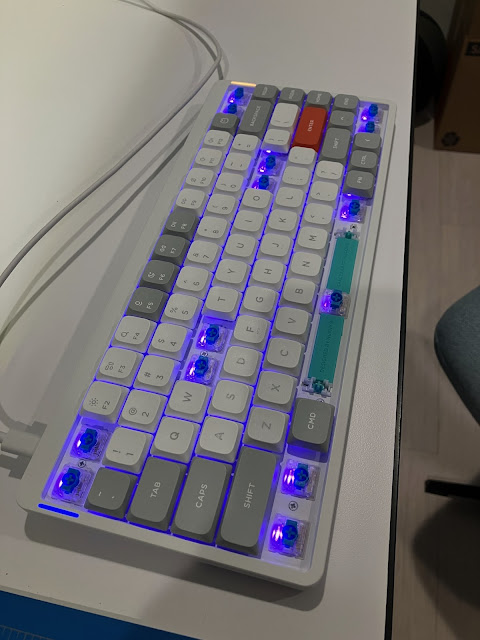As I may have mentioned in passing, I recently picked up some mechanical keyboards to improve my typing life. One of those was a NuPhy Air75 v2, which I had been using as my daily driver for my work laptop.
I'd been using it via a bluetooth connection in order to keep the cable clutter down, and after a couple days of this it eventually ran down the battery far enough to power itself off.
So naturally I plugged it back in to charge it back up, and I observed the light on the right hand side blinking yellow to indicate it was charging. I left it plugged in for a few hours to hopefully get a full charge, then pulled the cord out.
And the keyboard immediately powered off.
I tried charging it a couple more times, in different modes (there's a switch on the back that lets you pick between BT, wired, and completely off) and nothing seemed to be able to squirt any charge into the battery. I even tried with multiple different USB ports, but no dice.
So I fired off an email to NuPhy support and, in the meantime, decided to pop open the keyboard to see if I could diagnose things on my own.
This process did not take long.
The battery, which is stuck down to the bottom tray of the keyboard, connects to the main PCB by way of a 3 pin Molex PicoBlade connector. On the left is the positive terminal, on the right is the negative, and in the middle is the NTC thermistor that's used to monitor battery temperature.
Or at least, that NTC wire is supposed to be in the middle.
But it clearly has other ideas about where it should be.
Without the thermistor connection, the charging circuit on the board won't be able to tell what temperature the battery is, and thus it won't initiate a charge cycle. This perfectly matches the symptoms I saw: the battery worked fine to supply power, but once it was drained it wouldn't accept a charge.
I sent another email to NuPhy support with this diagnosis, and they got back to me asking for a copy of the purchase invoice which I provided, and then they told me that they'd send out a replacement barebones keyboard, and I'd just have to swap the key switches and key caps over to it.
So, problem solved. Sort of. Now I had a new problem: figuring out what to do with this completely worthless pile of e-waste garbage that used to be a functional keyboard.
Well, if you know me, you probably know what's coming next. I'm going to do engineering to it.
So, to fix this connector, we first need to depin the center contact from the connector housing. The metal of the crimp had hardened enough during crimping to make uncrimping it pretty unlikely, but I could at least fit the end of the wire into the larger jacket crimp.
My poor iPhone doesn't take amazing quality shots at this zoom level, so let's get a closer look.
With a dab of flux and a little kiss from my soldering iron, the conductors are secured to the pin, both physically and electrically.
Never mind that little melted whoopsie on the edge of the case.
And again, microscope for clarity.
Just in case you're wondering how big this connector is, here's my fingertip for scale.
Back into the connector it goes.
And if we plug it in and check the voltage we see...
It is indeed charging! Success!
The keyboard snaps together pretty easily, and is secured by 8 screws.
And then it's back in business.
Of course, that does leave the question of what to do with the new "replacement" keyboard when it arrives. What to do, what to do indeed?











No comments:
Post a Comment